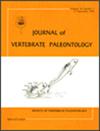Rare osteohistological evidence of skeletal maturity in the early diverging traversodontid Scalenodon angustifrons , with comments on histological sampling coverage in CynodontiaCitation for this article: Kulik, Z. T. (2023) Rare osteohistological evidence of skeletal maturity in the early diverging traversodontid Scalenodon angustifrons , with comments on histological sampling coverage in Cynodontia. Journal of Vertebrate Paleontology . https://doi.org/10.1080/02724634.…
IF 1.9
4区 地球科学
Q2 PALEONTOLOGY
引用次数: 0
Abstract
ABSTRACTTo date, 25 species of non-mammalian cynodonts have been histologically sampled, but few record a definitive and well-developed external fundamental system (EFS) indicative of skeletal maturity. Here, I report an EFS in the femoral histology of Scalenodon angustifrons and discuss the factors that could explain why skeletally mature tissue is rarely documented in cynodont osteohistology. My sample includes two equivalently sized individuals that document marked histological variation, as only one shows evidence of slowing growth rate and an EFS. Variation in the bone histology between femora of the same size suggests that attainment of skeletal maturity does not follow a discrete developmental pattern for S. angustifrons, a pattern that is also seen in the bone histology of other traversodontids and some non-gomphodontian cynodonts. From these results, a flexible growth strategy is inferred for S. angustifrons. To contextualize the validity of this pattern among other cynodont species, I summarize the sampling coverage of cynodonts that have been thin-sectioned and report limited coverage across size classes/ inferred development stages. This is often a result of sampling one isolated element that is not standardized to one skeletal element, which contributes to a poorly constrained comparative sample (in terms of size coverage, spatial and temporal resolution, and taxonomic coverage). Despite this, many cynodont species show shifts towards slow growth, but very few instances of unequivocal evidence of skeletal maturity. This result underscores the need for standardized iterative histological sampling to assess longevity, life history, and developmental patterns of non-mammalian cynodonts more accurately. ACKNOWLEDGMENTSI thank the 2007 and 2012 field crews to Tanzania (K. Angielczyk, L. Nampunju, S. Nesbitt, C. Sidor, R. Smith, S. Steyer, M. Stocker, N. Tabor, A. Tibaijuka, L. Tsuji), C. Abramson for preparing NMT RB581, and K. Abrams for her expertise in molding, casting, and specimen preparation. Thanks to L. Marilao for her skilled thin-section preparation, to S. Powers and J. Ricks for their help in curating the Tanzanian collection housed at the Burke Museum, and to Crystal Shin for her expert scientific illustration. For their helpful feedback, edits, and advice, I thank M. Whitney, B. Gee, T. Popowics, A. Huttenlocker, and C. Sidor. Lastly, two anonymous reviewers are thanked for their comments and suggestions that greatly improved the quality of this work. Fossils were collected with support from NGS 7787-05 and NGS 8962-11 (to C. Sidor), NSF DBI-0306158 (to K. Angielczyk).DISCLOSURE STATEMENTNo potential conflict of interest was reported by the author.DATA AVAILABILITY STATEMENTThe osteohistological data that support the findings of this study are openly available in MorphoBank at http://morphobank.org/permalink/?P4541, reference number P4541.Kulik, Z. T.(2023)关于早期分叉的横齿鲨(Scalenodon angustifrons)骨骼成熟的罕见骨组织证据,并对横齿鲨(Cynodontia)的组织学采样覆盖率进行了评论。古脊椎动物杂志。https://doi.org/10.1080/02724634..。
迄今为止,已经对25种非哺乳动物犬齿动物进行了组织学采样,但很少有记录表明骨骼成熟的明确和发达的外部基本系统(EFS)。在这里,我报告了角鲨(Scalenodon angustifrons)股骨组织学上的一个EFS,并讨论了可以解释为什么骨成熟组织很少在犬齿骨组织学上被记录的因素。我的样本包括两个同等大小的个体,记录了明显的组织学变化,因为只有一个显示出生长速度减慢和EFS的证据。相同大小的股骨之间的骨组织变化表明,骨成熟的实现并不遵循S. angustifrons的离散发育模式,这种模式也可以在其他横齿类和一些非gomphodontian犬齿动物的骨组织中看到。根据这些结果,推断出了一种灵活的生长策略。为了将这种模式在其他犬齿动物物种中的有效性背景化,我总结了已被薄切片的犬齿动物的采样覆盖率,并报告了在大小类别/推断的发展阶段的有限覆盖率。这通常是采样一个孤立元素的结果,该元素没有标准化为一个骨架元素,这导致比较样本的约束很差(在大小覆盖、空间和时间分辨率以及分类覆盖方面)。尽管如此,许多犬齿动物物种表现出向缓慢生长的转变,但很少有骨骼成熟的明确证据。这一结果强调需要标准化的反复组织学采样来更准确地评估非哺乳动物犬齿动物的寿命、生活史和发育模式。感谢2007年和2012年坦桑尼亚的现场工作人员(K. Angielczyk, L. Nampunju, S. Nesbitt, C. Sidor, R. Smith, S. Steyer, M. Stocker, N. Tabor, A. Tibaijuka, L. Tsuji), C. Abramson准备NMT RB581, K. Abrams在成型、铸造和样品制备方面的专业知识。感谢玛丽劳(L. Marilao)熟练的薄切片制作,感谢鲍尔斯(S. Powers)和里克斯(J. Ricks)帮助策展伯克博物馆(Burke Museum)的坦桑尼亚藏品,感谢克里斯托·辛(Crystal Shin)专业的科学插图。我感谢M. Whitney、B. Gee、T. Popowics、A. Huttenlocker和C. Sidor提供的有益反馈、编辑和建议。最后,感谢两位匿名审稿人的评论和建议,他们极大地提高了本文的质量。化石的收集得到NGS 7787-05和NGS 8962-11 (to C. Sidor), NSF DBI-0306158 (to K. Angielczyk)的支持。声明作者未报告潜在的利益冲突。数据可用性声明支持本研究结果的骨组织学数据可在MorphoBank中公开获取,网址为http://morphobank.org/permalink/?P4541,参考号为P4541。
本文章由计算机程序翻译,如有差异,请以英文原文为准。
求助全文
约1分钟内获得全文
求助全文
来源期刊
CiteScore
2.90
自引率
7.10%
发文量
58
审稿时长
4-8 weeks
期刊介绍:
The Journal of Vertebrate Paleontology publishes original contributions on all aspects of vertebrate paleobiology, including vertebrate origins, evolution, functional morphology, taxonomy, biostratigraphy, phylogenetics, paleoecology, paleobiogeography, and paleoanthropology. JVP publishes high quality peer-reviewed original articles, occasional reviews, and interdisciplinary papers. It is international in scope, and emphasizes both specimen- and field-based based research and the use of high-quality illustrations. Priority is given to articles dealing with topics of broad interest to the entire vertebrate paleontology community and to high-impact specialist studies. Articles dealing with narrower topics, including notes on taxonomic name changes (unless these deal with errors published in JVP), preliminary site reports, and documentation of new specimens of well-known taxa, are afforded lower priority.

 求助内容:
求助内容: 应助结果提醒方式:
应助结果提醒方式:


